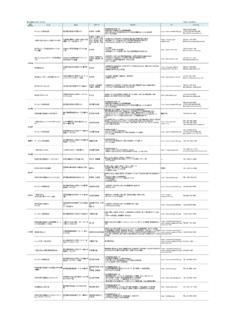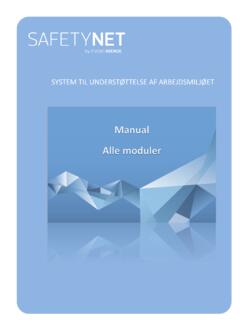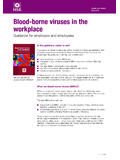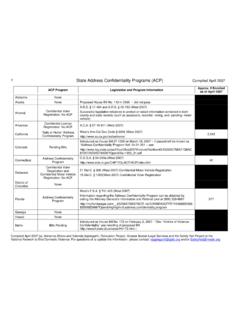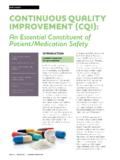Transcription of DEFINITION – HEALTH CARE SAFETY NET - CPHS
1 DEFINITION HEALTH care SAFETY NET. Prepared by the Commission on the Public's HEALTH System Based on data from the Committee of Interns and Residents For Medicaid Matters NY and the Save Our SAFETY Net-Campaign July 30, 2012. Importance HEALTH care SAFETY Net Providers (SNP), or in NYS terminology Vital Access Providers (VAP), are institutions that are critical in providing care and services in low-income, medically underserved, immigrant and communities of color. These facilities are most often located in these communities, or nearby, and are serving the community. Most have limited HEALTH care resources available forcing residents to go without care or having to travel outside of their own community for services. In New York State, there is a noticeable disparity in the ability of SNP and academic medical centers (AMCs), along with large teaching hospitals, to exist and function. These hospitals have wealthy board members and endowments available to tap for additional dollars. This is typically not true for SNPs which are typically located in low- income communities, have large percentage of patients either without HEALTH insurance coverage, or covered by Medicaid.
2 In both cases, a great deal less reimbursement is available for these facilities. A hospital with 50% Medicaid patient load, usually already financially challenged, is inordinately hurt by across-the-board cuts as opposed to more affluent institutions , Brookdale vs. NYU Langone Medical Center with very limited low-income patients. This inequity is compounded by the State's current method of allocating charity care dollars (federal DSH dollars). Although required, the allocation of these dollars does not follow uninsured patients. The distribution also does not follow the requirement that high Medicaid hospitals be targeted for increased allocation from this pool. Some large AMCs and teaching hospitals with low Medicaid caseloads and insignificant services for uninsured patients are well-paid from this pool. The community HEALTH centers (FQHCs). also provide services to Medicaid and uninsured patients. There is a separate pool of funding for charity care provided by FQHCs which is tied to their reporting care provided for uninsured patients.
3 However, this pool is much smaller than the hospital pool so that FQHC's receive smaller percent of the cost of providing this care . Unintended Consequences The inequity in how hospitals, and other HEALTH care providers are funded, leads to the weakening of institutions in medically underserved, low income communities. Hospitals that have closed, with the exception of St. Vincent's Medical Center in Manhattan, have been located in medically underserved communities. An attached map shows the overlap of closed hospitals and medically underserved community designation. In one instance, after the closing of St. Mary's Hospital in Central Brooklyn in 2006, it was not possible to identify what happened to 40% of the patients using this hospital. The closing also endangered the FQHCs run by the hospital. Of the seven clinics, five were transferred to Kingsbrook Jewish, but only one is still in operation. Short of closing, financially weakened hospitals are often pushed into crisis, unable to pay their bills, fund needed capital improvements, and continue to accumulate debt.
4 With benign neglect, the state feels the need to act on the developing crisis. The most recent example of this is the HEALTH System Redesign: Brooklyn Work Group of the Medicaid Redesign Team. Five hospitals in North and Central Brooklyn were identified as financially challenged and in need of targeted interventions. Clearly, going from crisis to crisis with no interim efforts to address the causes of this problem will continue to happen if not adequately addressed. Making assumptions that the closing of SAFETY net providers will not have an impact on access to care in medically underserved communities is flawed reasoning. There are many barriers to access to care in low-income communities. Focusing on policies that maintain SAFETY net providers is critical, and becomes even more important as we prepare for the phasing in of the Affordable care Act and some of the uninsured population becomes eligible for HEALTH insurance coverage. Defining the SAFETY Net and Designing Remedies The Institute of Medicine defines the HEALTH care SAFETY net as: Those providers that organize and deliver a significant level of HEALTH care and other related services to uninsured, Medicaid, and other vulnerable populations (IOM, America's HEALTH care SAFETY Net: Intact but Endangered, 2000).
5 The National Association of Public Hospitals and HEALTH Systems (NAPH) adds that they are distinguished by their commitment to provide access to care for people with limited or no access to HEALTH care due to their financial circumstances, insurance status, or HEALTH condition (NAPH, What is a SAFETY Net Hospital?). The IOM's report further defines core SAFETY net providers as having: 1. legal mandate or explicitly adopted mission, they maintain and open door'. [policy], offering patients access to services regardless of their ability to pay; . and 2. a substantial share of their patient mix [that] is uninsured, Medicaid, and [members of] other vulnerable populations. (IOM). It is crucial for the state to address the financial HEALTH and ability to provide quality HEALTH care services by SAFETY net HEALTH care providers. A recent Commonwealth Fund publication identified the problem and recommendations to address the problem. (Toward a High Performance HEALTH care System for Vulnerable Populations: Funding for SAFETY -Net Hospitals.)
6 March 2012.). ( ). There are several specific recommendations: 1. New York State's Medicaid hospital rates are below the cost of efficiently delivered care , states should increase Medicaid rates paid to hospitals with the highest share of Medicaid patients and lowest share of privately insured as a share of all their patients and this increase in rate should be tied to targeting quality improvements. 2. States should consider the relationship between inpatient and outpatient services, incentivizing the delivery of care in the most appropriate and efficient setting and supporting clinical integration across hospitals and community-based settings.. 3. States should invest in reimbursement rates for services where there is insufficient capacity to meet the needs of Medicaid beneficiaries and where increased Medicaid payments may enhance access.. Special program funding, including Medicaid and Medicare DSH payments, must be targeted to SAFETY net HEALTH care providers to ensue their ability to continue providing, and improving HEALTH care services.
7 The State proposed Vital Access Program (VAP) should incorporate the DEFINITION , proposals, and criteria proposed for SAFETY net providers. Rural SAFETY Net Providers There are differences between the urban and rural SAFETY net providers. Often a rural provider is a sole provider to an entire community, which is not always the case in urban settings. Rural populations have access problems related to insurance coverage and provider supply. (Rural HEALTH care SAFETY Nets. Agency for Healthcare Research and Quality. ( ) Rural hospitals are more likely to be government run. Providers in rural communities are less likely to be formal SAFETY net providers found in urban areas. There are special classes of providers in rural areas: Rural HEALTH Clinics and Critical Access Hospitals. These providers should receive SAFETY net funding as they serve this function in their communities. Some data Based on hospital submitted ICR data from the State HEALTH Department, information compiled by the Committee of Interns & Residents (CIR), the Commission on the Public's HEALTH System (CPHS) prepared charts that identified SAFETY net hospitals in New York City.)
8 The identification is based on reaching a certain percent of Medicaid and uninsured patient services. The 2008 chart prepared in 2010 is clear based on the State data as all payer data is presented by inpatient, outpatient (including ER), and overall services. The 2010 data chart prepared in 2012 makes it more difficult to clearly identify all SAFETY net providers as outpatient data is not provided, and the only data by payer is for overall services. The list of hospitals looks very different based on this new way of presenting data. For the 2010 chart, any New York City hospital with at least 25% Medicaid and uninsured for overall services is defined as a SAFETY Net Provider. For some hospitals, the data is from 2009. If there is no percentage shown for 2010/2009, the hospital did not meet the 25% cut-off. Hospital 2010/2009 2008. Brooklyn Interfaith 31% Beth Israel/Kings Highway* 21%. Woodhull Coney Island Kings County Lutheran Brooklyn Wyckoff Bronx Bronx-Lebanon St. Barnabas Jacobi Lincoln North Central Bronx Manhattan Harlem Metropolitan Bellevue** (all Manhattan Hospitals had less than 15% Medicaid and uninsured).
9 Queens Elmhurst Queens Jamaica Staten Island (none). *Beth Israel Kings Highway these numbers are inordinately high and need to be checked **Bellevue these numbers are inordinately low and need to be checked.

